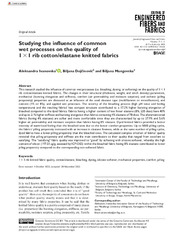Prikaz osnovnih podataka o dokumentu
Studying the influence of common wet processes on the quality of 1 × 1 rib cotton/elastane knitted fabrics
| dc.creator | Ivanovska, Aleksandra | |
| dc.creator | Dojčinović, Biljana | |
| dc.creator | Mangovska, Biljana | |
| dc.date.accessioned | 2023-01-10T10:18:52Z | |
| dc.date.available | 2023-01-10T10:18:52Z | |
| dc.date.issued | 2022 | |
| dc.identifier.issn | 1558-9250 | |
| dc.identifier.uri | http://TechnoRep.tmf.bg.ac.rs/handle/123456789/5292 | |
| dc.description.abstract | This research studied the influence of common wet processes (i.e. bleaching, dyeing, or softening) on the quality of 1 × 1 rib cotton/elastane knitted fabrics. The changes in their structural (thickness, weight, and stitch density) parameters, mechanical (bursting elongation and stiffness), comfort (air permeability and moisture sorption), and esthetic (pilling propensity) properties are discussed as an influence of the used elastane type (multifilament or monofilament), and content (4% or 8%), and applied wet processes. The severity of the bleaching process (high pH value and boiling temperature) and the resulting fabrics’ less compact structure contributed to a 17.3% higher bursting elongation of bleached compared to the dyed fabrics. Fabrics having a higher content of less finner elastane (8%, 235 dtex) have 40% and up to 21% higher stiffness and bursting elongation than fabrics containing 4% elastane of 78 dtex. The aforementioned fabrics (having 4% elastane) are softer and more comfortable since they are characterized by up to 37.9% and 5.6% higher air permeability and moisture sorption than fabrics having 8% elastane. Dyed knitted fabrics provided a better intensity of warm/cool feeling than the bleached ones due to the better comfort properties. Up to 5000 pilling cycles, the fabrics’ pilling propensity increased with an increase in elastane fineness, while at the same number of pilling cycles, dyed fabrics have a lower pilling propensity than the bleached ones. The calculated complex criterion of fabrics’ quality revealed that pilling propensity and stiffness are the main contributors to their quality that ranged from excellent to satisfying. The “satisfying” fabric quality was improved to “good” by softening with silicone softener, whereby the high content of silicon (197.51 μg/g, assessed by ICP-OES) within the bleached fabric having 8% elastane contributed to lower piling propensity compared to the corresponding non-softened fabric. | sr |
| dc.language.iso | en | sr |
| dc.publisher | SAGE Publications Ltd | sr |
| dc.relation | info:eu-repo/grantAgreement/MESTD/inst-2020/200287/RS// | sr |
| dc.rights | openAccess | sr |
| dc.rights.uri | https://creativecommons.org/licenses/by/4.0/ | |
| dc.source | Journal of Engineered Fibers and Fabrics | sr |
| dc.subject | 1×1 rib knitted fabric quality | sr |
| dc.subject | cotton/elastane | sr |
| dc.subject | bleaching | sr |
| dc.subject | dyeing | sr |
| dc.subject | silicone softener | sr |
| dc.subject | mechanical properties | sr |
| dc.subject | comfort | sr |
| dc.subject | pilling | sr |
| dc.title | Studying the influence of common wet processes on the quality of 1 × 1 rib cotton/elastane knitted fabrics | sr |
| dc.type | article | sr |
| dc.rights.license | BY | sr |
| dc.citation.rank | M22~ | |
| dc.citation.volume | 17 | |
| dc.identifier.doi | 10.1177/15589250221145522 | |
| dc.identifier.fulltext | http://TechnoRep.tmf.bg.ac.rs/bitstream/id/13789/Studying_the_influence_pub_2022.pdf | |
| dc.identifier.scopus | 2-s2.0-85144825900 | |
| dc.type.version | publishedVersion | sr |

